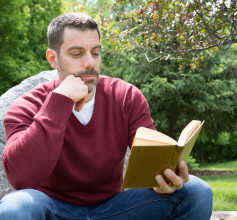“I did nothing today”–“What? Did you not live? That is not only the most fundamental but the most illustrious of your occupations.” Montaigne, Essays, III, 13, “On Experience”
For Montaigne, living is an art and living well is not a task that should be left for our two week vacations or right before we turn out the light at night, but something we should take seriously and tend to everyday. He suggests that we spend so much time adorning our outer lives with riches and honor that we miss out on discovering who we really are. “Every man rushes elsewhere and into the future, because no man has arrived at himself” (On Physiognomy). For Montaigne, we have it backwards. We think that the trappings of our outer lives (e.g. job, house, car, clothes, etc.) gives our inner lives meaning and purpose, when in fact, the key to living a full life is doing the hard work of exploring and cultivating our inner lives. This means that we need to find out, as best we can, who we really are, accept what we find (the good, the bad, and the ugly), spend the time working through what we don’t like and cultivating what you do like, and finally bringing it all together into a harmonious whole. The ancient philosopher Plotinus uses the apt analogy of sculpting a statue to describe his process of beautifying the soul.
“How can one see the beauty of a good soul?” Withdraw into yourself and look. If you do not as yet see beauty within you, do as does the sculptor of a statue that is to be beautified: he cuts away here, he smooths it there, he makes this line lighter, this other one purer, until he disengages beautiful lineaments in the marble. Do you this, too. Cut away all that is excessive, straigthen all that is crooked, bring light to all that is overcast, labor to make all one radiance of beauty. Never cease “working the statue”…(I.6,9)
Sculpting the soul illustrates the idea that living well is an art, something that demands the right tools, the right skills, and, of course, constant practice.
The first thing we need to realize is that we are unique creatures. We are lucky to even be alive. What are the chances that the universe would unfold in such as way that we would be sentient beings that are aware of our own unique existence? Nietzsche at the beginning of his essay “Schopenhauer as Educator” says that,
“At bottom, every human being knows perfectly well that he lives in the world just once…and that no coincidence, regardless how strange, will ever for a second time concoct out of this amazingly variegated diversity the unity that he is.”
He asks why people don’t embrace, and live out of, their own uniqueness but follow the “herd” and the conventions of society. He believes that people are both fearful and lazy and “what they fear most are those hardships that unconditional honesty and nakedness would foist upon them.”
He suggests that it’s the artist that expresses the truth of our situation,
“Artists alone despise this lethargic promenading draped in borrowed manners and appropriated opinions, and they expose the hidden secret, everyone’s bad conscience, the principle that every human being is a one-of-a-kind miracle. They dare to show us how every human being, down to each movement of his muscles, is himself and himself alone; moreover, they show us that in the strict consistency of his uniqueness he is beautiful and worthy of contemplation, as novel and incredible as every work of nature, and anything but boring.”
It follows from this that we should embrace this fact and take responsibility for exploring, cultivating, and sculpting our unique and inimitable inner selves.
“We are accountable to ourselves for our own existence; consequently, we also want to be the real helmsman of our existence and keep it from resembling a mindless coincidence. We have to approach existence with a certain boldness and willingness to take risks…why cling to this clod of earth, to this trade; why heed what your neighbors say?”
Taking on this responsibility is no easy task. We are not only unique but mysterious. As Heraclitus says, “the soul is undiscovered though explored forever to a depth beyond report.” So we need to find out who we really are and who we want to be. This requires us to actively turn around and go inside ourselves and sit with our own mystery. We need to look and see what’s down there. We can’t discover everything, but we can discover hidden aspects of ourselves that drive our everyday behavior and color our general attitude towards life. We must have the patience to explore our inner depths and the courage to face up to what we might find. Next, we need the commitment to work through, integrate, and “sculpt” our discoveries so that we can be the “helmsman” of our own lives. This requires action, taking risks, and trying things out. In “Self-Reliance” Emerson sums this up in the following way,
“The power which resides in him is new in nature, and none but he knows what that is which he can do, nor does he know until he has tried.”
Since we are “new in nature,” the process of discovery and integration will be different for each person.
In the end, this is not something we can do in a day or on a week long retreat. Just as the artist needs to master her technique through constant practice, we need to master our own technique for living so that we can be the artist of our own lives. “That is not only the most fundamental but the most illustrious of your occupations.”
![]() The Art of Living by Philosophical Living is licensed under a Creative Commons Attribution-NonCommercial-NoDerivatives 4.0 International License.
The Art of Living by Philosophical Living is licensed under a Creative Commons Attribution-NonCommercial-NoDerivatives 4.0 International License.
